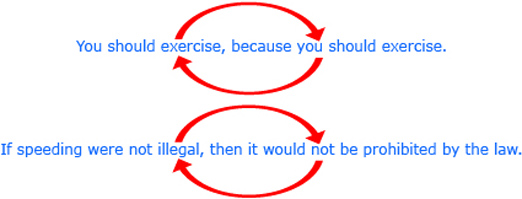Lesson 4
1. Lesson 4
1.3. Explore 2
Module 2: Logic and Geometry
Self-Check 1
Complete “Practising” question 5 on page 43 of your textbook. Answer
Identifying errors in a proof may involve understanding the way mathematical operations are allowed to be applied. Logically, you know that 1 does not equal 2; but some proofs can be quite convincing. Watch Proving 2 = 1 and see if you can spot the error in the proof.
Read “Example 2: Using reasoning to determine the validity of a proof” on pages 37 and 38 of your textbook. How is the error in this proof similar to the error in the proof that 2 = 1?
Self-Check 2
Complete “Practising” question 3 on page 42 of the textbook. Answer
premise: a statement assumed to be true1
Proofs that include an argument that is based on a false statement are invalid. Even if a valid argument is used, if one or more of the starting premises are not true, the conclusion cannot be true.
Read “Example 3: Using reasoning to determine the validity of a proof” on page 39 of your textbook. As you read, think about what happens to a conclusion that is based on a false assumption?
circular reasoning: an argument that is incorrect because it makes use of the conclusion to be proved2
Example 3 is an example of circular reasoning. Circular reasoning uses the conclusion that is to be proved as part of the argument. In other words, you assume that what you are supposed to be proving is true and use that statement as part of your proof. This is like arguing in a circle and is not a valid form of reasoning. The following statements and arguments are examples of circular reasoning.

1 Adapted from: CANAVAN-MCGRATH ET AL. Principles of Mathematics 11, © 2012 Nelson Education Limited. p. 38. Reproduced by permission.
2 Adapted from: CANAVAN-MCGRATH ET AL. Principles of Mathematics 11, © 2012 Nelson Education Limited. p. 39. Reproduced by permission.
